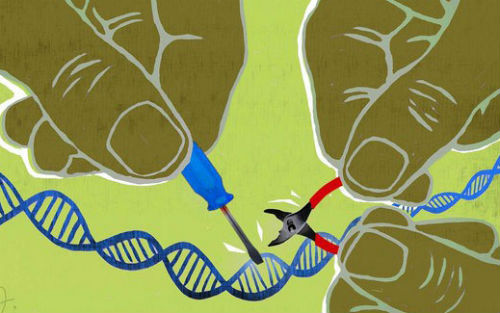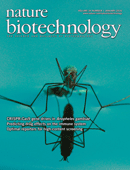Gene editing technology CAS9-CRISPR 2
source:未知 author:admin Release time:2020-02-15 12:02 Browse volume:
Guide
Significant improvements have been made, with an unprecedented success rate of up to 60% when replacing one piece of DNA with a short piece of DNA. The researchers described their new technology in the January 21 issue of Nature Biotechnology.
Researchers at the University of California, Berkeley have made significant improvements to CRISPR-Cas9 technology, achieving unprecedented success rates of up to 60% when replacing one piece of DNA with a short DNA fragment. The researchers described their new technology in the January 21 issue of Nature Biotechnology.
This improved technique is especially useful when trying to repair genetic mutations that cause hereditary diseases such as sickle cell disease or severe combined immunodeficiency. It enables researchers to patch abnormal DNA fragments with normal sequences and has the potential to repair this defect, which has already played a role in cell culture to promote repair of defective genes.
"The exciting thing about CRISPR-Cas9 is that it has the potential to repair genes in our genome, but it can be inefficient," said Jacob Corn, scientific director of the University of California, Berkeley's innovative genomics program. "If you think of gene editing as It's a word processor, we know how to cut, but we need a more efficient way to paste a new piece of DNA at the site where we cut. "
Problems with short DNA fragments, including single base mutations, are typical of many genetic diseases. "This technique will be very effective if you want to change some very small DNA regions that are 30bp in length," said Christopher Richardson, the first author of the paper and a postdoctoral fellow in the Innovative Genomics Project.
Richardson discovered that Cas9 developed a new method long after cleavage of double-stranded DNA-still attached to the chromosome for up to 6 hours. Richardson took a closer look at the Cas9 protein, which binds to two DNA strands, and found that the protein tightly grasped the three nicked ends while one nicked end was unrestricted.
When Cas9 cuts DNA, the repair system in the cell grabs a piece of complementary DNA and uses it as a template to repair the cut. Researchers can add templates that make changes to existing sequences in the genome, such as correcting disease-causing mutations.
Richardson speculated that bringing this alternative template directly to the cutting site would improve repair efficiency. He constructed a DNA fragment that matched the free DNA end and carried a genetic sequence that would be inserted into the other end. This technology works extremely well, resulting in a mutation repair success rate of 60%.
"Our data suggest that the breaks caused by Cas9 at the molecular level may be different from those generated by other targeted nucleases such as TALENS and zinc finger nucleases, which means that the strategies we are adopting can make you more Effectively repairs fractures caused by Cas9. "
The researchers also confirmed that some Cas9 protein variants that bind but do not cut DNA can also successfully paste a new DNA sequence at the binding site, which may play a role by attracting a "bubble" structure on the target DNA. Fixes template. Corn said that the use of Cas9, which does not cut the genome, for gene editing eliminates the risk of off-target cutting in the genome and may be safer than standard gene editing.

While some research groups are working to expand the basics and clinical applications of CRISPR-Cas9 technology, other researchers are constantly working to improve the efficiency of this technology, expand its targeting range, and address the issue of off-target effects.
Researcher Wang Haoyi from the Institute of Zoology, Chinese Academy of Sciences confirmed in a research paper in the June 2015 issue of Genetics that the use of electrical current to transmit the CRISPR / Cas9 system not only enables CRISPR / Cas9 to efficiently implement laboratory mouse genetics Retrofit and significantly increase the throughput of this system.
Whitehead Institute scientists have significantly increased the efficiency of CRISPR / Cas by 19 times by adding an anticancer drug, Scr7, to genetically edited fertilized eggs. This important result was published in the journal Nature Biotechnology.
A research team from the Massachusetts General Hospital (MGH) has adopted a variant of KKH SaCas9 to increase the targeting range of CRISPR-Cas9 by 2-4 times. The results were published in the November 2015 issue of Nature Biotechnology.
references
I want to add literature
Enhancing homology-directed genome editing by catalytically active and inactive CRISPR-Cas9 using asymmetric donor DNA
Enhancing homology-directed genome editing by catalytically active and inactive CRISPR-Cas9 using asymmetric donor DNA
Literature search: doi: 10.1038 / nbt.3481

Link source: http://www.biodiscover.com/news/research/172440.html
Significant improvements have been made, with an unprecedented success rate of up to 60% when replacing one piece of DNA with a short piece of DNA. The researchers described their new technology in the January 21 issue of Nature Biotechnology.
Researchers at the University of California, Berkeley have made significant improvements to CRISPR-Cas9 technology, achieving unprecedented success rates of up to 60% when replacing one piece of DNA with a short DNA fragment. The researchers described their new technology in the January 21 issue of Nature Biotechnology.
This improved technique is especially useful when trying to repair genetic mutations that cause hereditary diseases such as sickle cell disease or severe combined immunodeficiency. It enables researchers to patch abnormal DNA fragments with normal sequences and has the potential to repair this defect, which has already played a role in cell culture to promote repair of defective genes.
"The exciting thing about CRISPR-Cas9 is that it has the potential to repair genes in our genome, but it can be inefficient," said Jacob Corn, scientific director of the University of California, Berkeley's innovative genomics program. "If you think of gene editing as It's a word processor, we know how to cut, but we need a more efficient way to paste a new piece of DNA at the site where we cut. "
Problems with short DNA fragments, including single base mutations, are typical of many genetic diseases. "This technique will be very effective if you want to change some very small DNA regions that are 30bp in length," said Christopher Richardson, the first author of the paper and a postdoctoral fellow in the Innovative Genomics Project.
Richardson discovered that Cas9 developed a new method long after cleavage of double-stranded DNA-still attached to the chromosome for up to 6 hours. Richardson took a closer look at the Cas9 protein, which binds to two DNA strands, and found that the protein tightly grasped the three nicked ends while one nicked end was unrestricted.
When Cas9 cuts DNA, the repair system in the cell grabs a piece of complementary DNA and uses it as a template to repair the cut. Researchers can add templates that make changes to existing sequences in the genome, such as correcting disease-causing mutations.
Richardson speculated that bringing this alternative template directly to the cutting site would improve repair efficiency. He constructed a DNA fragment that matched the free DNA end and carried a genetic sequence that would be inserted into the other end. This technology works extremely well, resulting in a mutation repair success rate of 60%.
"Our data suggest that the breaks caused by Cas9 at the molecular level may be different from those generated by other targeted nucleases such as TALENS and zinc finger nucleases, which means that the strategies we are adopting can make you more Effectively repairs fractures caused by Cas9. "
The researchers also confirmed that some Cas9 protein variants that bind but do not cut DNA can also successfully paste a new DNA sequence at the binding site, which may play a role by attracting a "bubble" structure on the target DNA. Fixes template. Corn said that the use of Cas9, which does not cut the genome, for gene editing eliminates the risk of off-target cutting in the genome and may be safer than standard gene editing.

While some research groups are working to expand the basics and clinical applications of CRISPR-Cas9 technology, other researchers are constantly working to improve the efficiency of this technology, expand its targeting range, and address the issue of off-target effects.
Researcher Wang Haoyi from the Institute of Zoology, Chinese Academy of Sciences confirmed in a research paper in the June 2015 issue of Genetics that the use of electrical current to transmit the CRISPR / Cas9 system not only enables CRISPR / Cas9 to efficiently implement laboratory mouse genetics Retrofit and significantly increase the throughput of this system.
Whitehead Institute scientists have significantly increased the efficiency of CRISPR / Cas by 19 times by adding an anticancer drug, Scr7, to genetically edited fertilized eggs. This important result was published in the journal Nature Biotechnology.
A research team from the Massachusetts General Hospital (MGH) has adopted a variant of KKH SaCas9 to increase the targeting range of CRISPR-Cas9 by 2-4 times. The results were published in the November 2015 issue of Nature Biotechnology.
references
I want to add literature
Enhancing homology-directed genome editing by catalytically active and inactive CRISPR-Cas9 using asymmetric donor DNA
Enhancing homology-directed genome editing by catalytically active and inactive CRISPR-Cas9 using asymmetric donor DNA
Literature search: doi: 10.1038 / nbt.3481

Link source: http://www.biodiscover.com/news/research/172440.html


Related news